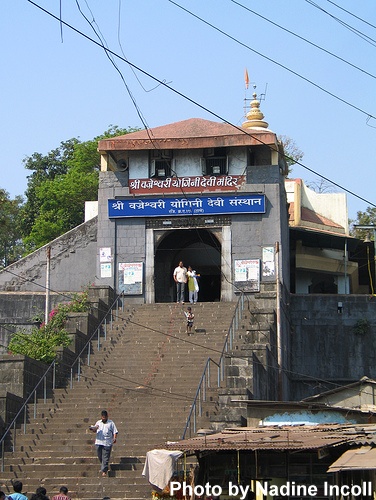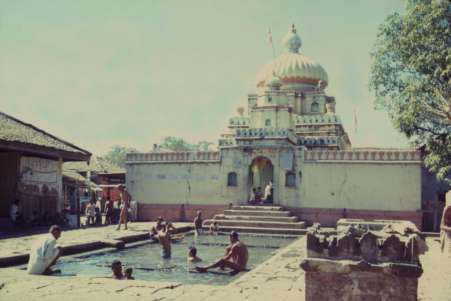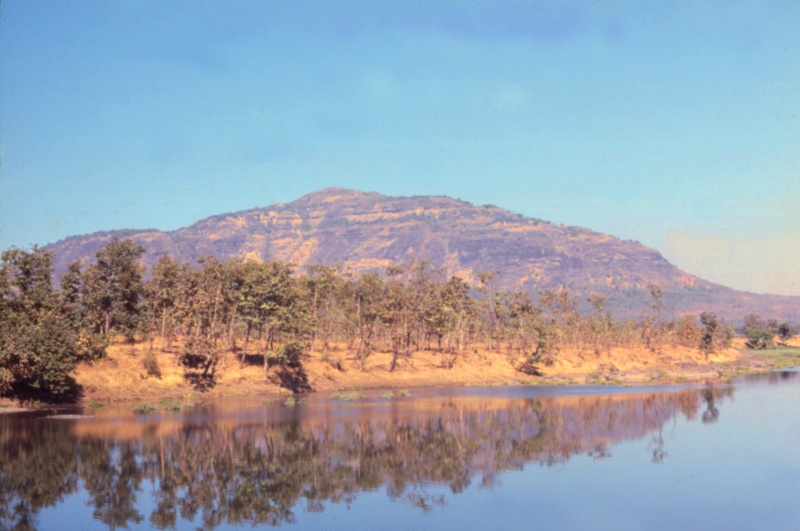| HOME | Translate |
|
| HOME | Translate |
|
|

Randall and Bob traveled to India on behalf of Sonoma State Universities "Field Experience in India" program. They were preparing a multimedia documentary journal, slide and audio production for public presentation highlighting the culture, philosophy and the spirituality of India. Vajreshwari
Mandir
The town of Vajreshwari - on banks of river Tansa - lies in Bhiwandi taluka, Thane district, Maharashtra, India and 31 km away from the nearest railway station of Vasai. The temple is located near the post office of Vajreshwari town, on the Mandagiri hillock, which was formed out of a volcanic eruption and is surrounded by hills on all sides. History
In 1739, Chimaji Appa - the younger brother and military commander of Peshwa Baji Rao I - had set camp in the Vadvali region on his way to capture the Portuguese held Bassein Fort of Vasai. The fort was unconquerable even after a three-year war. So Chimaji appa prayed to goddess Vajreshwari that if he could conquer the fort and defeat the Portuguese, he would build a temple to the goddess. According to legend, goddess Vajreshwari appeared in the dream of Chimaji Appa and told him the way to conquer the fort. On the 16 May, the fort fell and defeat of Portuguese in Vasai was complete. To celebrate his victory and to fulfill the vow taken in front of goddess Vajreshwari, Chimnaji appa ordered the new Subhedar (governor) Shankar Kasav Phadke to build the Vajreshwari temple. The temple' architecture is based on Bassein Fort. The Nagarkhana in main entrance gate was built by the Gaikwads, Maratha dynasty of Baroda. The stone steps leading to the temple and the Dipamala (A tower of lights) in front of the temple were built by Nanasaheb Chandavadakar, a moneylender from Nashik. Legends
The primary deity of the temple, Vajreshwari (vajre?vari), also spelled Vajreshvari, also known as Vajrábái and Vajrayogini, is considered as incarnation of goddess Parvati or Aadi-Maya on earth. Her name literally means "the lady of the Vajra (thunderbolt)". There are two legends about the goddess' origins, both associated with the Vajra. Thousands of years ago, a Rakshasa (demon) named Kalikala or Kalikut troubled the rishis (sages) and humans in the region of Vadvali and waged a war against the devas (gods). Distressed the gods and sages headed by Vashishta performed the TriChandi yagna, a fire offering to the Goddess, to please Her. An aahuti (offering of ghee in yajna) was not granted to Indra (king of devas). Enraged, Indra hurled his Vajra - one of most powerful weapons in Hindu mythology- at the yajna. The terrified gods and sages prayed to the Goddess to save them. The Goddess appeared in all her glory at the site and not only swallowed the Vajra and humbled Indra but also killed the demons. Rama requested the Goddess that she should stay in the region of Vadvali and be known as Vajreshwari. Thus, the Vajreshwari temple was established in this region. Another legend says that Indra and other devas went to goddess Parvati and requested her to help slay demon Kalikala. Goddess Parvati assured that she will come to their aid at the right time and ordered them to fight with the demon. In the battle, Kalikala swallowed or broken all weapons thrown at him. Finally, Indra threw the Vajra at the demon, which Kalikala broke into pieces and from the Vajra, emerged the Goddess, who destroyed the demon. The devas extolled her as Vajreshwari and built her temple. The 7th canto of Navanath Kathasar states that Machindranath served goddess Vajrabhagawati (Vajreshwari) for a month by giving her a bath of the water of hot springs. Temple
structure
The main shrine has three sections: the main inner sanctum (Garbha g?ha), another sanctum and a pillared mandapa (assembly hall). The Grabha-griha houses six idols. The saffron murti (idol) of goddess Vajreshwari with a sword and a gada (mace) in her right and left hands respectively and a trisula (trident) besides her, stands in the centre. Murtis of goddess Renuka (Parshurama's mother) with a sword and a lotus in her hands, goddess Saptashrungi Mahalakshmi of Vani and a tiger, goddess Vajreshwari's vahana or mount; are to the left of goddess Vajreshwari. On her right are the murtis of goddess Kalika (the village goddess) with a lotus and a kamandalu (water pot) and Parshurama armed with a parshu (axe). The goddesses are adorned with silver jewelry, crowns and stand on silver lotuses and are sheltered by silver umbrellas. The sanctum outside the Garbhagriha has idols of Ganesha, Bhairava, Hanuman and local deities like Moraba devi. The assembly hall has a bell, which devotees ring when entering the shrine and a marble lion, also believed to be the goddess' mount. A Yajna kunda (a structure in which a fire offering is done) is outside the assembly hall. Smaller shrines in temple
premises are dedicated to Kapileshwar Mahadeva (Shiva), Datta, Hanuman
and saints of Giri Gosavi sect. A peepal tree in front of the Hanuman shrine,
has assumed a form of Ganesha and is worshipped as the deity. The sam?dhi
(tomb) of the 17th century Giri Gosavi saint Godhadebuwa is further atop
the Gautam hill, behind the Mandagiri hillock.
|
Vajreshwari
Mandir


|
Bhagawan Nityananda lived at Akloli Kund Shiva Temple for 8 years until 1958. "Though the Vajreshwari temple seems to be the centre of all activity, Vajreshwari would have been any other non-descript semi-urban hinterland town had it not been for the nearby hot-water springs. A couple of tiled-tanks in front of a Shiva temple trap the water of seven hot water springs. Since the water is running water, the fact that dozens take a dip in the tanks shouldn’t be a cause of worry. Also, since the waters are laden with minerals, the water appears blackish. |
Akloli
Kund Shiva Mandir


Akloli
Kund Shiva Mandir in 1971 and 2010

Mandakini
Mountain in the dry season


|